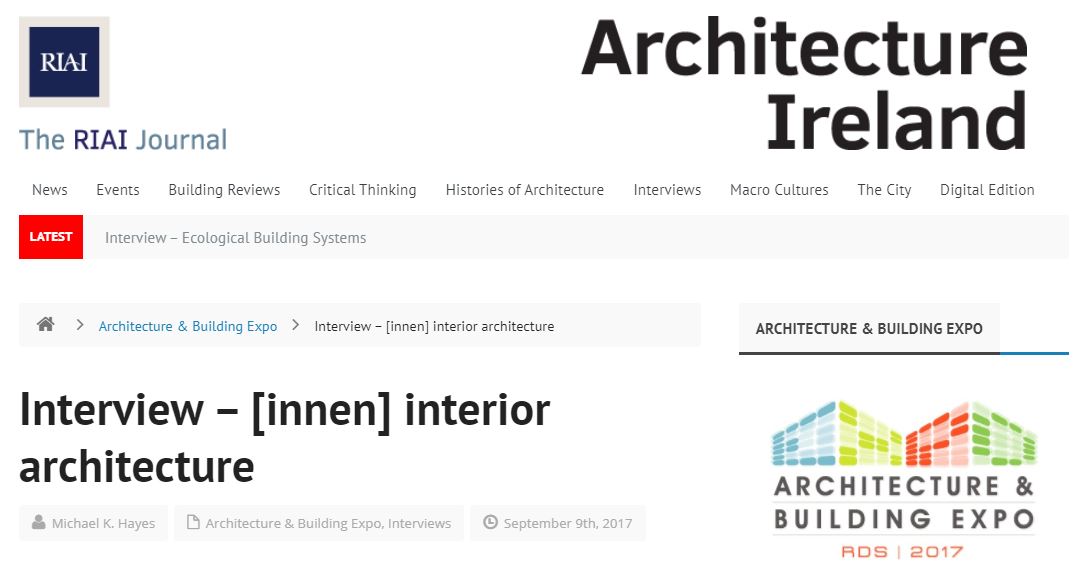HERE the link to this recent interview with the RIAI Journal ‘ARCHITECTURE IRELAND’about our last year’s winning entry as
Fit-Out of the Year under € 1 million at the Interior Design & Fit-Out Awards at Architecture Expo 2016.
Interview – [innen] interior architecture
As we look forward to the upcoming Architecture and Building Expo, 6-7 October, Architecture Ireland takes a look at the Expo’s annual Interior Design & Fit-Out Awards through a series of interviews with 2016′s winning practices.
In this article, we speak with Andreas Heil of [innen] interior architecture. In 2016, [innen] interior architecture were awarded the ‘Commercial up to €1m’ Award for the Mortuary Chapel at Dublin Airport.
[innen] won an award in 2016 for the Mortuary Chapel at Dublin Airport – could you please tell us about the initial aims and brief for this project and some of the main challenges involved?
This project takes a special place amongst my other works, as it is a very personal one. A very good friend of mine died abroad some years ago as an ex-pat architect in China. I was humbled to be asked by his family to be present when we welcomed his remains back on Irish soil. As sad as the occasion was, I could not help but being discomforted by the state in which the ‘airport mortuary’ presented itself. It took me a while to approach the DAA with a proposal to re-design the facility. So I came up with the brief myself, which was essentially to create the most dignified environment possible for the deceased, and their family and friends during this traumatic moment in their lives. To get the DAA on board for a project that had neither a brief formulated nor a budget allocated, I had to convince them with a winning idea. I found a great ally in Andrew Baker, the DAA Head of Property, who was instrumental in making this happen once he saw the dramatic transformation my design would offer. Within a limited budget, I proposed to radically improve the space by building a room within the room. That way I could shut out some of the existing distressing factors, like direct views onto a busy cargo car park or disturbing noise from the adjacent cargo handling facility. I wanted to completely alter the experience for any future visitor and user.
The design of contemporary religious spaces can often be challenging. The symbology of the past is no longer as relevant as it once was, yet there is often still a desire to provide a sense of solemnity and tradition. How did you approach these issues in your design and were there are precedents which particularly influenced you?
To be honest, I did not look into precedents. I wanted to let myself be led by my own recent experience, the space itself, and my fundamental idea of how to transform it. The facility had to be multi-denominational, so I could not work with recognisable symbolism of any specific religion, but had to draw instead onto a more profound ‘language’ of humanity that would be relevant to members of all cultures. I designed the space to surround visitors in gentle curves, to cocoon them and to address their basic human need for comfort. Repetitive vertical warm oak fins densify towards the centre axis and give the room direction and focus. Symmetry creates a sense of calm and balance. In the ‘apsis’ the elliptic walls continue into a semi-circle. This circle is completed by a semi-circle of oak fins that are suspended from the ceiling. These elements surround the coffin and put the deceased into the centre of the mourners’ universe during that delicate moment in their lives. The tilted circle of the ceiling feature is continued in finely crafted cut-outs in the wall fins – together they form a transcendent ring around the dead as a symbol of eternity. Finally, a gold-painted deep cylindrical cut-out in the ceiling above the coffin connects to a light-filled but intangible space above, which eludes to the concept of an afterlife that runs through all major religions. The warmth of the materials and considered lighting were crucial to the intimate feel of the space.
How did it feel to have a prize-winning entry in the Interior Design and Fit-Out Awards 2016? Has the award influenced your practice in any way?
I have to admit I was absolutely chuffed when the winner was announced at the award ceremony – particularly as the project also had a particularly personal aspect for me. This form of recognition is a great confidence booster and encourages me to keep following my (design) beliefs. I only started my own design studio five years ago, so it feels good to be recognised as a David amongst the Goliaths of the Irish design industry.
With your experience of Interior Design and Fit-Out, what are the main changes you’ve witnessed in the area of the last number of years and do you have any predictions for the future of the sector?
The wide accessibility to information through digital media and the emergence of platforms like Pinterest have made our clients vastly more tuned into matters of design. Therein lies potential and risk at the same time. As a designer, you don’t necessarily have to travel the world anymore to find your influences as we have international work literally at our fingertips. However in this new globalised world it becomes even more important to find a unique design voice that is specifically relevant to a unique location and a defined client and brief. Clients are definitely much more visually educated, but will still benefit from the sensitive eye and multi-layered training of an interior architect.
The future? Just look at the discussion emerging in the car industry – we are not far from seeing diesel cars banned from inner cities. For our sector, sustainability and environmental impact are factors that are here to stay and gain in importance. In addition, it is possible that there will be more advanced computer programmes with the ability to produce a ‘design’ with a mouse-click. However, I predict it will be a far cry from a unique and cohesive response full of soul and spirit – it’s not chess after all.
Can we expect to see any recently completed work entered into the 2017 Interior Design and Fit-Out Awards this year? Have you any current interior design and fit-out awards on the drawing board at the moment which particularly excite you?
Yes, of course we will submit something again. In a recent fit-out we encountered one of these rare moments when the stars seem to align – where client, designer and contractor had a strong common vision to deliver an extraordinary project. Whether it’s award-worthy, that’s for the judges to decide!
Andreas is an interior architect with twenty years of design industry experience He is principal of design studio [innen] interior architecture, and lectures part time in Interior Architecture at Griffith College. He describes his work simply as ‘Creating experiences – Designing for people. Not more. Not less.’ www.innendesign.ie/


